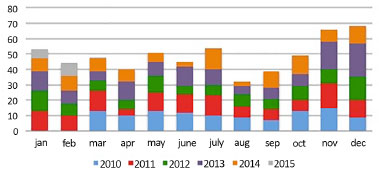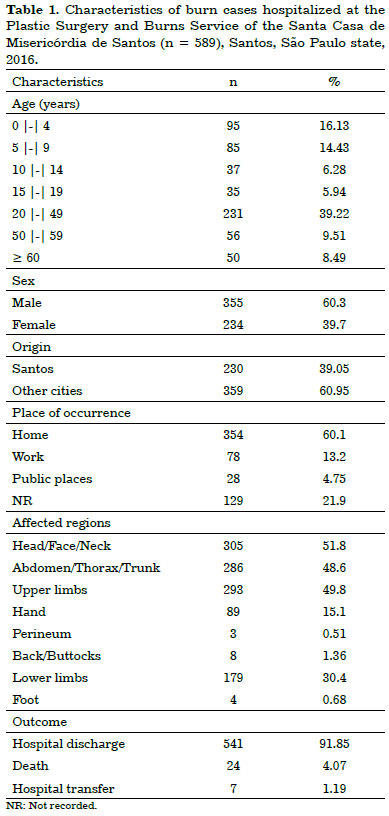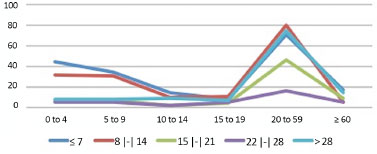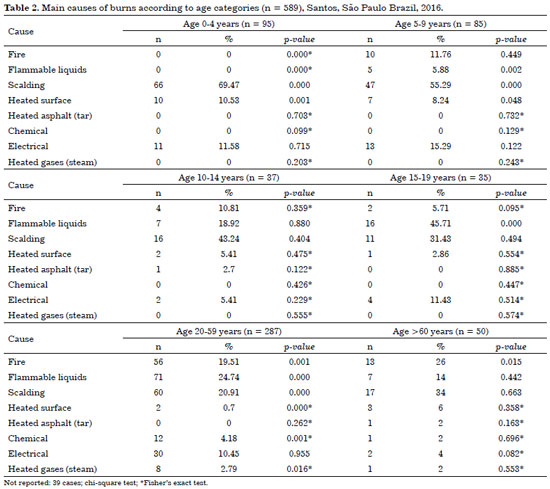

Original Article - Year 2017 - Volume 32 - Issue 4
Epidemiology of burn cases hospitalized at the Plastic Surgery and Burns Service of Santa Casa de Misericórdia de Santos, Brazil
Epidemiologia dos pacientes vítimas de queimaduras internados no Serviço de Cirurgia Plástica e Queimados da Santa Casa de Misericórdia de Santos
ABSTRACT
INTRODUCTION: Burns are skin injuries caused by external agents and can result in functional, aesthetic, psychological, and fatal sequelae. The objective is to determine the epidemiological profile of burn cases hospitalized at the Plastic Surgery and Burns Service of Santa Casa de Misericórdia de Santos (Serviço de Cirurgia Plástica e Queimados da Santa Casa de Misericórdia de Santos-SCPQSCMS).
METHODS: A total of 589 burn cases hospitalized at SCPQSCMS from March 2010 to March 2015 were evaluated.
RESULTS: Of these, 180 were children (aged <10 years), 72 were adolescents, 287 were adults, and 50 were elderly. The majority of the study sample were men, and the primary place of occurrence was the home. The most commonly affected regions were the head, face and neck, abdomen, thorax and trunk, and upper limbs. Burns were mainly caused by scalding (36.8%), flammable liquids (18%), fire (14.4%), and electrical injuries (10.5%). The average hospitalization time was 22 days; however, 61% of the sample remained hospitalized for up to 2 weeks and 4% died.
CONCLUSIONS: The study demonstrated that the profile of patients hospitalized at SCPQSCMS was similar to that found in other units specializing in this type of treatment. Our results emphasize the importance of this type of study to understand and avoid risk factors and behaviors associated with burns.
Keywords: Burns; Epidemiology; Accident prevention; Burn units; Public health.
RESUMO
INTRODUÇÃO: Queimaduras são caracterizadas por uma lesão da pele causada por um agente externo, que podem resultar em sequelas funcionais, estéticas, psicológicas e até mesmo a morte. O objetivo é traçar o perfil epidemiológico dos pacientes vítimas de queimaduras internados no Serviço de Cirurgia Plástica e Queimados da Santa Casa de Misericórdia de Santos (SCPSCMS).
MÉTODOS: Foram analisados 589 casos de queimaduras internados no período de março de 2010 a março de 2015, no Serviço de Cirurgia Plástica e Queimados da Santa Casa de Misericórdia de Santos.
RESULTADOS: 180 pacientes eram crianças (< 10 anos); 72 adolescentes; 287 adultos e 50 idosos. A maioria da amostra eram homens e o principal local de ocorrência o domicílio. As regiões afetadas mais frequentes foram a cabeça, face e pescoço, abdome, tórax e tronco, além dos membros superiores. Constatou-se como principais agentes causais a escaldadura (36,8%), seguida dos líquidos inflamáveis (18%), fogo (14,4%) e queimadura elétrica (10,5%). O tempo de internação foi em média 22 dias, contudo, 61% da amostra permaneceu internada por até 2 semanas e, apenas 4% foram a óbito.
CONCLUSÕES: O estudo demonstrou que o perfil do paciente internado por queimadura no SCPSCMS é compatível com o descrito por outras unidades especializadas nesse tipo de tratamento. Ressalta-se a importância desse tipo de estudo para conhecer e intervir em fatores e comportamentos de risco para queimaduras.
Palavras-chave: Queimaduras; Epidemiologia; Prevenção de acidentes; Unidades de queimados; Saúde pública.
Burns are skin injuries caused by external agents, with partial or complete destruction of the skin in some body surface areas due to thermal, electrical, chemical, or radioactive trauma1.
Burns are the fourth most common type of traumatic injury worldwide, after traffic accidents, falls, and interpersonal violence, and represent a major global public health challenge as among the most severe injuries2. The World Health Organization estimated that there were more than 7.1 million accidental fire-related burns worldwide in 2004, with an overall incidence of 110 cases per 100,000 inhabitants per year3.
Approximately 90% of burns occur in low- to middle-income countries in regions that lack the necessary infrastructure to reduce the incidence and severity of these events2. The Brazilian Burn Society estimates that 1 million burn injuries occur each year in Brazil; of these, 200,000 are treated by emergency services and 40,000 require hospitalization4,5.
Previous studies have reported that burns represent severe, complex, and multidisciplinary trauma that can cause functional, aesthetic, and psychological sequelae, and even death4,6. Burn injuries also have social, economic, and public health implications. Database searches found that few epidemiological studies have been performed on burn injuries in Brazil; most of these were concentrated in a few centers specialized in the treatment of burns and were based on international data.
It is known that preventive methods can improve with specific strategies focused on public health education. Therefore, more studies are necessary to understand the epidemiology of burns.
Most studies of burn injuries indicate a need to understand epidemiology to prevent this type of trauma. Leão et al.1 highlighted the importance of prevention to reduce the morbidity and mortality caused by burns because most cases are preventable. Prevention programs are the best means of avoiding burns and their harmful effects in humans, as noted by Souza et al.7.
Lacerda et al.8 reported that the epidemiological data collected in burn units in Brazil allows health institutions to determine the demand for beds by geographical region, as well as outcome parameters, hospitalization time, bed occupancy, mortality, and infection rate, and use of materials, including antibiotics, blood products, and temporary skin substitutes; this information is essential to improve administrative planning, treatment, and rehabilitation for burn injuries.
Leitão et al.9 emphasized the importance of continued education to prevent avoidable events caused by carelessness in home activities, poor child care, inadequate handling of flammable products, and failure to use personal protective equipment at work.
Therefore, these types of studies are essential to understand and avoid risk factors and behaviors and can guide the adoption of public policies for prevention, education, and regulation.
OBJECTIVE
The objective of the present study was to determine the epidemiological profile of burn cases hospitalized at the Plastic Surgery and Burns Service of Santa Casa de Misericórdia de Santos (Serviço de Cirurgia Plástica e Queimados da Santa Casa de Misericórdia de Santos-SCPQSCMS), São Paulo, Brazil, from 2010 to 2015, in order to understand the characteristics of this population and to improve services and educational policies for the prevention of burns.
METHODS
This retrospective cross-sectional observational study was conducted using data collected from electronic medical records of SCPQSCMS from 2010 to 2015. The study was approved by the Research Ethics Committee of our institution and registered at the Brazil Registry under Certificate for Ethics Assessment (Certificado de Apresentação para Apreciação Ética - CAAE) No. 62945316.7.0000.5448. Patients with second- and third-degree burns were included in the study; patients who were admitted to the Burn Service but did not require hospitalization and those with incomplete records were excluded.
The collected data were entered on a spreadsheet and analyzed using statistical software (STATA version 13.1; StataCorp, TX, USA). For descriptive statistics, numerical variables were expressed as mean, median, standard deviation (SD), and 95% confidence interval (95% CI), and categorical variables were expressed as absolute (n) and relative (%) frequencies. Associations were examined using the chi-square or Fisher's exact test, and p-values less than 0.05 were considered significant.
RESULTS
A total of 589 burn cases were hospitalized from March 2010 to March 2015 at the SCPQSCMS. Figure 1 shows the historical trend. Of the 589 cases, 111 (18.9%) were treated in 2010, 125 (21.2%) in 2011, 105 (17.8%) in 2012, 131 (22.2%) in 2013, 102 (17.3%) in 2014, and 15 in 2015 (from January to March). The number of cases was higher in January, July, November, and December.

Figure 1. Historical trend of burn cases treated at the Santa Casa de Misericórdia de Santos (n = 589) from 2010 to 2015. Santos, São Paulo, Brazil, 2016.
The mean age of the study population was 28.1 ± 21.8 years (95% CI, 26.3-29.8). Of these, 30.5% were aged <10 years (16% were aged 0-4 years and 14% were aged 5-9 years), 39.2% were aged 20-49 years, 9.5% were aged 50-59 years, and 8.5% were older than 60 years; most patients (60.3%) were men.
Most cases occurred in Santos (39.1%), with the rest occurring in nearby coastal cities (São Vicente, Praia Grande, Guarujá, and Cubatão). The most common places of occurrence were the home (60.1%), work environment (13%), and public places (4.8%) (Table 1).

The length of hospital stay was highly variable, with a median of 12 days and mean of 21.6 ± 28.1 days (range, 0-207). Most patients (61%) were hospitalized for up to 14 days, and 120 (21%) were hospitalized for more than 28 days. Adults aged 20 to 59 years were hospitalized for a longer period (Figure 2).

Figure 2. Hospitalization time for burn cases by age group at the Santa Casa de Misericórdia de Santos (n = 589) from 2010 to 2015. Santos, São Paulo, Brazil, 2016.
With regard to severity, 86.5% (n = 508) of cases were second-degree burns, 9.2% (n = 54) were second- and third-degree burns, and 4.3% (n = 25) were third-degree burns. Among the most severe cases (third-degree burns), 68% (n = 17) involved the hands and 44% occurred in individuals aged 20 to 59 years. The median body surface area affected (SCQ) was 11%, with a minimum of 1% and maximum of 91% (n = 479).
Most patients (91.9%) were discharged and only 4.1% (n = 23) died. Of these, 11 patients had second-degree burns (five patients were aged 20 to 59 years and six were older than 60 years) and 12 had second- and third-degree burns (one patient was aged 10-14 years, five were aged 20-59 years, and six were older than 60 years).
Burns were most commonly caused by scalding (36.8%), flammable liquids (18%), fire (14.4%), and electrical injuries (10.5%). Data were categorized according to age and are shown in Table 2.
Burns caused by fire were significant in those aged 0-4 years and >20 years. Flammable liquids, scalding, and heated surfaces were more common causes of injury in those aged 0-9 years and 15-59 years. Burns due to chemicals and heated gases were only significant in adults aged 20 to 59 years.
DISCUSSION
Burns are severe injuries associated with morbidity and mortality; however, their incidence in Brazil is unknown. For this reason, the understanding of the epidemiology and the most frequent causes of burns may aid in the development of health policies related to prevention, treatment, and rehabilitation10.
Our results agree with those of other studies, with the highest number of cases occurring in the age group 20 to 49 years, in males, and in the home environment. The main causative agents were flammable liquids, fire, scalding, and heated surfaces and gases. The epidemiological analysis conducted by Coutinho et al.6 indicates that this age group comprises the largest productive work force, and includes young adults (aged 20 to 30 years); this group also has the highest rate of thermal lesions.
Chemical burns were more common in this age group and occurred in the work environment in 75% of cases. Gimenes et al.11 reported that although most cases occur in the home, the high percentage of occupational accidents should not be underestimated, and investment in education and incentives for the use of individual and collective protective equipment are essential.
Our results revealed that 16% of burn cases were in the age group 0 to 4 years and 14% were in those aged 5 to 9 years. Other studies4,10,11 reported that scalding was the primary cause, indicating the importance of prevention in this age group. Millan et al.10 indicated that these cases might be correlated with the neu ropsychomotor development of children. When no longer entirely dependent on adults, a child begins to walk and experience the world more freely, and parents need to be attentive and vigilant in this developmental phase.
Among the elderly, scalding and fire were the primary causes, as reported in an epidemiological study by Bastos et al.12. The authors also observed that despite the low incidence in the elderly, this population has a high risk of mortality and represents 33-63% of reported cases.
The average hospitalization time in our study was 22 days, and the majority (61%) of the study population was hospitalized for up to 14 days. These results agree with those of other Brazilian studies1,4,6,9. The body regions most commonly affected were the thorax and upper limbs, and this result was corroborated by a descriptive study conducted by Leão et al.1 in Minas Gerais.
The mortality rate found in this study (4%) agrees with the results of previous studies5,6. A total of 23 patients died in our sample. Of these, 12 were elderly (24%, 12/50), 10 were young adults (3.5%, 10/287), and one was an adolescent (1.4%, 1/72). Dias et al.5 found that the mortality rate reported by burn units was strongly correlated with the social and economic conditions of the involved countries. Moreover, this rate reflects the severity of the accidents and is dependent on the education level of the population, promotion of prevention campaigns, quality of electrical distribution networks, and resources available for the treatment of burns, among other factors.
CONCLUSION
This study demonstrated that the profile of burn cases admitted to the Plastic Surgery and Burns Service of Santa Casa de Misericórdia de Santos was similar to that found in other burn units.
These findings are important for understanding and avoiding risk factors and behaviors that are associated with burns, and can be used in the prevention of domestic accidents, care for children and the elderly, educational policies, supervision of the sale of flammable liquids, and guidance in the use of personal protective equipment at work.
COLLABORATIONS
GACP Analysis and/or interpretation of data; statistical analyses; final approval of the manuscript; conception and design of the study; writing the manuscript or critical review of its contents.
JMN Analysis and/or interpretation of data; statistical analyses; final approval of the manuscript; conception and design of the study; writing the manuscript or critical review of its contents.
ALDQ Analysis and/or interpretation of data; statistical analyses; final approval of the manuscript; writing the manuscript or critical review of its contents.
RPP Final approval of the manuscript; writing the manuscript or critical review of its contents.
SCSJ Analysis and/or interpretation of data; final approval of the manuscript; writing the manuscript or critical review of its contents.
REFERENCES
1. Leão CEG, Andrade ES, Fabrini DS, Oliveira RA, Machado GLB, Gontijo LC. Epidemiologia das queimaduras no estado de Minas Gerais. Rev Bras Cir Plást. 2011;26(4):573-7.
2. Peck MD, Kruger GE, van der Merwe AE, Godakumbura W, Ahuja RB. Burns and fires from non-electric domestic appliances in low and middle income countries Part I. The scope of the problem. Burns. 2008;34(3):303-11. DOI: http://dx.doi.org/10.1016/j.burns.2007.08.014
3. Othman N, Kendrick D. Epidemiology of burn injuries in the East Mediterranean Region: a systematic review. BMC Public Health. 2010;10:83. DOI: http://dx.doi.org/10.1186/1471-2458-10-83
4. Aragão JA, Aragão MECS, Filgueira DM, Teixeira RMP, Reis FP. Estudo epidemiológico de crianças vítimas de queimaduras internadas na Unidade de Tratamento de Queimados do Hospital de Urgência de Sergipe. Rev Bras Cir Plást. 2012;27(3):379-82. DOI: http://dx.doi.org/10.1590/S1983-51752012000300008
5. Dias LDF, Oliveira AF, Juliano Y, Ferreira LM. Unidade de Tratamento de Queimaduras da Universidade Federal de São Paulo: estudo epidemiológico. Rev Bras Cir Plást. 2015;30(1):86-92.
6. Coutinho BBA, Balbuena MB, Anbar RA, Anbar RA, Almeida KG, Almeida PYNG. Perfil epidemiológico de pacientes internados na enfermaria de queimados da Associação Beneficente de Campo Grande Santa Casa/MS. Rev Bras Cir Plást. 2010;25(4):600-3.
7. Souza AA, Mattar CA, Almeida PCC, Faiwichow L, Fernandes FS, Neto ECA, et al. Perfil epidemiológico dos pacientes internados na Unidade de Queimaduras do Hospital do Servidor Público Estadual de São Paulo. Rev Bras Queimaduras. 2009;8(3):87-90.
8. Lacerda LA, Carneiro AC, Oliveira AF, Gragnani A, Ferreira LM. Estudo epidemiológico da Unidade de Tratamento de Queimaduras da Universidade Federal de São Paulo. Rev Bras Queimaduras. 2010;9(3):82-8.
9. Leitão EPC, Gomes HFC, Silva VAT, Santana RV. Estudo epidemiológico de pacientes internados na unidade de tratamento de queimados do Hospital Geral de Vila Penteado - São Paulo. Rev Bras Cir Plást. 2014;29(2):264-8.
10. Millan LS, Gemperli R, Tovo FM, Mandaçolli TJ, Gomez DS, Ferreira MC. Estudo epidemiológico de queimaduras em crianças atendidas em hospital terciário na cidade de São Paulo. Rev Bras Cir Plást. 2012;27(4):611-5. DOI: http://dx.doi.org/10.1590/S1983-51752012000400024
11. Gimenes GA, Alferes FCBA, Dorsa PP, Barros ACP, Gonella HA. Estudo epidemiológico de pacientes internados no centro de tratamento de queimados do conjunto hospitalar de Sorocaba. Rev Bras Queimaduras. 2009;8(1):14-7.
12. Bastos GPFDS, Olegario NBC, Pinheiro AMRS, Bastos VPD. Estudo epidemiológico dos pacientes idosos queimados no Centro de Tratamento de Queimados do Hospital Instituto Doutor José Frota do município de Fortaleza-CE, no período de 2004 a 2008. Rev Bras Queimaduras. 2010;9(1):7-10.
1. Santa Casa de Misericórdia de Santos, Santos, SP, Brazil
2. Sociedade Brasileira de Cirurgia Plástica, Santos, SP, Brazil
3. Clínica de Cirurgia Plástica Dr. Esaú, Santos, SP, Brazil
Institution: Santa Casa de Misericórdia de Santos, Santos, SP, Brazil.
Corresponding author:
Gustavo Almeida Carmo de Padua
Santa Casa de Misericórdia de Santos, Departamento de Cirurgia Plástica e Queimados
Avenida Dr. Cláudio Luís da Costa, 50 - Jabaquara
Santos, SP, Brazil - Zip Code 11075-101
E-mail: gustavoapadua@hotmail.com
Article received: February 2, 2017.
Article accepted: September 23, 2017.
Conflicts of interest: none.



 Read in Portuguese
Read in Portuguese
 Read in English
Read in English
 PDF PT
PDF PT
 Print
Print
 Send this article by email
Send this article by email
 How to Cite
How to Cite
 Mendeley
Mendeley
 Pocket
Pocket
 Twitter
Twitter